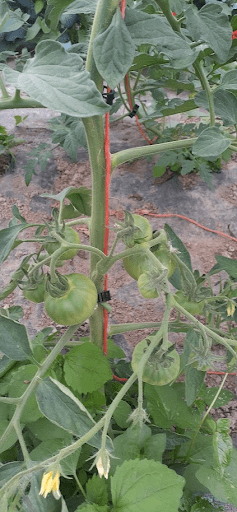In today’s post, I am going to focus on how to embrace low-till gardening systems, but first a quick refresher on soil.
The importance of soil
- Soil is a living and complex natural covering of the Earth.
- Soil acts as a sponge to absorb water, nutrients, pollutants, and carbon.
- Many aspects of soil cannot be changed, but properties can be managed to provide the elements needed to grow desired plants and it is the pillar of plant life in your landscape/ecosystem.
- Chemical, physical, and biological components make up the living soil.
- Soil scientists are only beginning to understand the complex biological systems and how important they are to overall soil health.
- Topsoil is the usable portion for gardeners. Thus, all management techniques should aim to protect and enhance this valuable layer.

Pros and cons of tilling garden soil
In-ground gardening techniques have long been the method of vegetable gardening used in large-scale production. This system focuses on the mechanical tilling of a section of the earth. This soil is prepared and then seeds or transplants are placed in rows. In between these rows of plants is the walkway, which is either tilled at regular intervals or mulched to prevent weeds from growing. This technique works well but results in high levels of soil disturbance. Mechanical tillers require the use of a motor or a large amount of physical labor/exertion if done by hand. Once the soil is tilled, it is more likely to suffer from soil compaction.
100% no-till gardening options
For alternative gardening methods that are 100% no-till, learn more by visiting these links:
Growing in Containers– University of Maryland Extension
Raised Beds– University of Maryland Extension
Lasagna Gardening or Sheet Mulching– Oregon State University Extension
Although tilling is the easiest and fastest way to create new planting areas and is also used as a weed control option, mechanical tilling of the soil (especially multiple times throughout the season) breaks down its structure and can reduce soil quality.
Negative effects of repeated mechanical tillage
Repeated tillage:
- Breaks down organic matter. The more often you are churning the soil the more the natural structure can be degraded and compacted. It disturbs natural pathways for water flow and for soil macro- and microorganisms.
- Reduces soil stability by breaking apart aggregates.
- Exposes rocks and deeper layers of soil that are less developed.
- Exposes the seed bank of the soil to light and allows new weed seeds to germinate.

Differences between conventional and low-till systems
Low-till gardening systems often look different than traditional gardening systems. Low-till management techniques focus more on installing permanent pathways that are not disturbed yearly. These pathways may be outlined with stones or other permanent items. In the actual planting bed, low tilling is done with a handheld tool to create the planting space. Often these tilled areas would be smaller in size.
Implement these practices slowly and expand as you have success.
- Use a broadfork to loosen the topsoil, but do not dig deeper than necessary. This allows the natural pathways made by micro- and macroorganisms (earthworm tunnels) and plant roots to stay intact.
- Keep the soil covered. Use mulch to prevent erosion. Mulch sourced from your landscape such as pine needles, grass clippings, clean straw, newspaper, cardboard, etc. can be used.
- Mother Nature always wants the soil to be covered. If you disturb the soil and do not cover it with mulch or other weed barrier, plants, or seeds, then weeds will grow. Wind and rain can quickly dissipate topsoil— replacing one inch of natural topsoil can take 500-1000 years! If the soil is covered it should not be as easy to wash or blow away.
- Add organic matter– whatever you have readily available. Mushroom compost, bagged cow manure, homemade compost, leaves, grass clippings, kitchen waste, etc.
- Plant crops (cover crops, green manure) that will be cut down and left to decompose naturally in the soil or lightly turned in with a broadfork.
- Comfrey (Symphytum officinale) and other plants can provide large amounts of nutrients when used as mulch.
- Fertilize and amend the soil based on analysis results. Test your soil every 3 years.
- Add fertilizer sources through amendments.
- Till or disturb the soil as close to planting time as possible. This helps to minimize the time when no plant roots are helping to stabilize the soil.
More details on improving soil structure can be found in the blog post: How Can You Improve Your Soil?

More on low-till gardens
Low-till is part of some permaculture practices. Permaculture practices have a goal of creating “permanent” growing spaces that utilize natural self-sustaining systems. Some of these permaculture practices can be adapted and used in our landscapes, especially those that include native plant areas, perennial fruits, and herbs. Other terms that incorporate these ideas and principles are food forests or forest gardening.
Tillage is a good tool, just remember to use it at the right time and for the right purpose to capture the benefits. Good soil management practices may be open to interpretation based on your personal goals for your garden space and remember that what makes sense in your landscape doesn’t always have to match what others are doing. If you are seeing positive results, then keep trying new techniques.
I hope that this Spring finds you dreaming and excited about the upcoming growing season and making a positive impact in adding diversity to your landscape.
Resources for more information
Soil management in home gardens and landscapes | Penn State University
No-till gardening keeps soil — and plants — healthy | Oregon State University
Low and no-till gardening | University of New Hampshire
By Ashley Bodkins, Senior Agent Associate and Master Gardener Coordinator, Garrett County, Maryland. Read more posts by Ashley.















